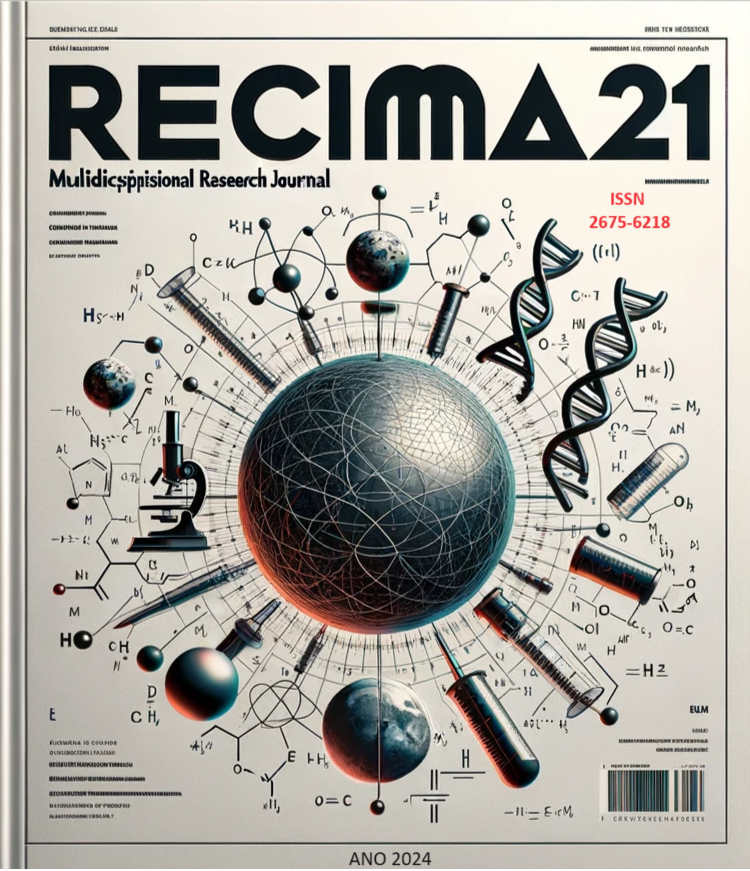PERCEPÇÃO AUDITIVA DA FALA EM USUÁRIOS DE IMPLANTE COCLEAR COM ELETRODOS DESATIVADOS: REVISÃO DE ESCOPO
DOI:
https://doi.org/10.47820/recima21.v5i3.5025Palavras-chave:
implante coclear, percepção auditiva da fala, eletrodos implantados, Falha de EquipamentoResumo
Este estudo teve como objetivo identificar, sintetizar e analisar o conhecimento científico produzido sobre a percepção auditiva da fala de pacientes usuários de Implante Coclear com eletrodos desativados. Desenho/Métodos: Trata-se de uma revisão de escopo seguindo as recomendações PRISMA realizada com base na seguinte pergunta norteadora: “Como é o desempenho da percepção auditiva da fala de pacientes usuários de Implante Coclear com eletrodos desativados?”. Combinações de descritores foram adaptadas para cinco bases de dados eletrônicas: PubMed/MEDLINE, Scopus, Embase, Web of Science e Lilacs, por meio dos descritores: implante coclear, percepção auditiva, percepção da fala, eletrodos implantados, falha de equipamentos médicos e falha de dispositivos. Entre os 550 estudos encontrados, 12 compuseram a amostra por responderem aos critérios de inclusão. Resultados: Todos estudos da amostra analisaram os usuários de Implante Coclear com eletrodos desativados com propósitos diferentes. Em sua maioria, foi verificado como o número de eletrodos habilitados ao longo do feixe interfere na percepção auditiva da fala. Conclusão: Embora não haja consenso na literatura quanto às repercussões na percepção auditiva da fala em pacientes com eletrodos desativados, estudos retrataram que ocorre uma limitação no desempenho quando o número de eletrodos é aumentado além de dez eletrodos, mas não há evidência suficiente que embasa a teoria de que há diminuição da percepção da fala nos casos de falha do eletrodo.
Downloads
Referências
Zeitler DM, Lalwani AK, Roland JT, Habib MG, Gudis D, Waltzman SB. The effects of cochlear implant electrode deactivation on speech perception and in predicting device failure. Otol Neurotol. 2009 Jan;30(1):7–13. DOI: https://doi.org/10.1097/MAO.0b013e31818a08ba
Wen C, Hwa TP, Kaufman AC, Brant JA, Eliades SJ, Bigelow DC, et al. Predictors of Postoperative Electrode Deactivation Among Adult Cochlear Implantees. Otol Neurotol [Internet]. 2021 Jul 1 [cited 2023 Dec 5];42(6):E675–83. Available from: https://journals.lww.com/otologyneurotology/fulltext/2021/07000/predictors_of_postoperative_electrode_deactivation.15.aspx DOI: https://doi.org/10.1097/MAO.0000000000003093
Sagi E, Svirsky MA. Deactivating cochlear implant electrodes to improve speech perception: A computational approach. Hear Res [Internet]. 2018;370:316–28. Available from: https://doi.org/10.1016/j.heares.2018.10.014 DOI: https://doi.org/10.1016/j.heares.2018.10.014
E A, Z M, editors. JBI Manual for Evidence Synthesi. Comprehensive Systematic Review for Advanced Practice Nursing, Third Edition. 2020. 295–349 p.
Tricco AC, Lillie E, Zarin W, Brien KKO, Colquhoun H, Levac D, et al. R ESEARCH AND R EPORTING M ETHODS PRISMA Extension for Scoping Reviews ( PRISMA-ScR ): Checklist and Explanation. 2018;(August 2016). DOI: https://doi.org/10.7326/M18-0850
Schvartz-Leyzac KC, Zwolan TA, Pfingst BE. Effects of electrode deactivation on speech recognition in multichannel cochlear implant recipients. Cochlear Implants Int. 2017 Nov 2;18(6):324–34. DOI: https://doi.org/10.1080/14670100.2017.1359457
Frijns JHM, Snel-Bongers J, Vellinga D, Schrage E, Vanpoucke FJ, Briaire JJ. Restoring speech perception with cochlear implants by spanning defective electrode contacts. Acta Otolaryngol. 2013 Apr;133(4):394–9. DOI: https://doi.org/10.3109/00016489.2012.754107
Lee FP, Hsu H Te, Lin YS, Hung SC. Effects of the electrode location on tonal discrimination and speech perception of mandarin-speaking patients with a cochlear implant. Laryngoscope. 2012 Jun;122(6):1366–78. DOI: https://doi.org/10.1002/lary.23313
Hamzavi J, Arnoldner C. Effect of deep insertion of the cochlear implant electrode array on pitch estimation and speech perception. Acta Otolaryngol. 2006 Dec 1;126(11):1182–7. DOI: https://doi.org/10.1080/00016480600672683
Rinia AB, Olphen AF, Dunnebier EA. Cochlear implantation in obstructed cochleas: The effect of the degree of obstruction on the number of activated electrodes and the amount of postoperative speech perception. Clin Otolaryngol. 2006 Aug;31(4):280–6. DOI: https://doi.org/10.1111/j.1749-4486.2006.01257.x
Yukawa K, Cohen L, Blamey P, Pyman B, Tungvachirakul V, O’Leary S. Effects of insertion depth of cochlear implant electrodes upon speech perception. Audiol Neuro-Otology. 2004;9(3):163–72. DOI: https://doi.org/10.1159/000077267
Liu T, Á HC, Lin H. Effects of Limiting the Number of Active Electrodes on Mandarin Tone Perception in Young Children Using Cochlear Implants. 2004;1149–55. DOI: https://doi.org/10.1080/00016480410017846
Hochmair I, Arnold W, Nopp P, Jolly C, Müller J, Roland P. Deep electrode insertion in cochlear implants: Apical morphology, electrodes and speech perception results. Acta Otolaryngol. 2003;123(5):612–7. DOI: https://doi.org/10.1080/000164803100001844
Hsu CJ, Horng MJ, Fu QJ. Effects of the number of active electrodes on tone and speech perception by Nucleus 22 cochlear implant users with SPEAK strategy. Adv Otorhinolaryngol. 2000;57:257–9. DOI: https://doi.org/10.1159/000059122
Holmes AE, Kemker FJ, Merwin GE. The effects of varying the number of cochlear implant electrodes on speech perception. Am J Otol. 1987 May;8(3):240–6.
de Melo TM, Bevilacqua MC, Costa OA. Speech perception in cochlear implant users with the HiRes 120 strategy: A systematic review. Braz J Otorhinolaryngol. 2012;78(3):129–33. DOI: https://doi.org/10.1590/S1808-86942012000300021
Saoji A, Litvak L, Boyle P. SPAN: improved current steering on the advanced bionics CII and HiRes90K system. Cochlear Implants Int. 2010;11 Suppl 1:465–8. DOI: https://doi.org/10.1179/146701010X12671177204381
Downloads
Publicado
Licença
Copyright (c) 2024 RECIMA21 - Revista Científica Multidisciplinar - ISSN 2675-6218

Este trabalho está licenciado sob uma licença Creative Commons Attribution 4.0 International License.
Os direitos autorais dos artigos/resenhas/TCCs publicados pertecem à revista RECIMA21, e seguem o padrão Creative Commons (CC BY 4.0), permitindo a cópia ou reprodução, desde que cite a fonte e respeite os direitos dos autores e contenham menção aos mesmos nos créditos. Toda e qualquer obra publicada na revista, seu conteúdo é de responsabilidade dos autores, cabendo a RECIMA21 apenas ser o veículo de divulgação, seguindo os padrões nacionais e internacionais de publicação.













